A Young Woman Seated at the Virginal
(attributed to Vermeer)Oil on canvas
c. 1670
25.2 x 20 cm. (9 7/8 x 7 7/8 in.)
Private collection, New York
EV SURVEY
Is A Young Woman Seated at the Virginals an authentic painting by Johannes Vermeer? Jonathan Janson
Jonathan Janson
Questions of Authenticity: What Science Can’t Tell Uslecture: International Vermeer Symposium, Rijksmuseum Amsterdam, March 29, 2023
Click here to read lecture.
There is an obvious connection between the National Gallery's Young Woman Seated at a Virginal and the Young Woman Seated at a Virginal in The Leiden Collection, (fig. 1) a small picture that for a long period led a relatively obscure life within Vermeer's oeuvre. Following debate among Vermeer experts about the work's authenticity, it was brought to the Rijksmuseum in 1963, where director Arthur van Schendel and art historian Frits Lugt compared it to the works by Vermeer in the museum's own collection. Hitherto unpublished correspondence from that year reveals that "the Vermeers in the Rijksmuseum were taken down and a scrupulous comparison made between them and the Beit picture"— so named after its former owner, Sir Alfred Lane Belt — 'and, as a result of this confrontation, both men who had previously been slightly skeptical were completely convinced of the picture's authenticity's Since this first visit of Young Woman Seated at a Virginal to the Rijksmuseum sixty years ago, a great deal of technical research has been done on the painting that has corroborated the Rijksmuseum's conclusion. In 2006, for instance, Libby Sheldon and Nicola Costaras were able to demonstrate clear similarities with the pigments and painting techniques used in Vermeer's late works. This also applies to his unique use of green earth in the shadowing of the face. In 2011, C. Richard Johnson and Don H. Johnson discovered that the painting was painted on a piece of canvas cut from the same roll of linen as the canvas Vermeer used for The Lacemaker. One area of conjecture remained, as it was unclear whether the yellow shawl the young woman wears around her shoulders was a later addition or one of Vermeer's pentimenti (corrections). Recent technical research at the Rijksmuseum, however, has shown conclusively that the yellow shawl was not painted by a later hand, but is the result of an alteration made by Vermeer himself during the painting process. In the initial design, the pleats of the satin skirt extend under the shawl, but in the final paint layers they do not continue, stopping instead at the shawl's edge. This confirms that the shawl and the skirt were elaborated at the same stage. Being that a strong stylistic kinship is evident with other works by Vermeer from the years 1670–1672, the painting is now accepted as authentic. It may be the last work by Vermeer to have survived.
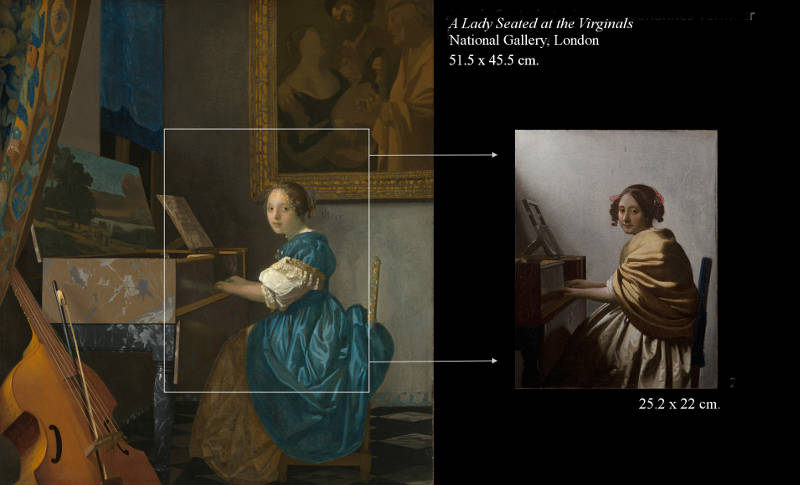
The figure size in the two pictures is practically the same but The Leiden Collection painting is considerably smaller.Through the cropping of the scene we have zoomed in in such a way that there is no longer any kind of barrier between us and the figure, allowing us to focus not just on her but also on how Vermeer conveyed how the light skims over the roughly textured wall behind her.The foreshortening of the virginal in both pictures is very similar, as are the fore-arms and hands resting on the keyboard. In its concentration on the motif of a woman at a virginal, the picture is not unlike Gabriel Metsu's rather more introverted treatment of the same subject on a nearly identical scale (fig. 2.
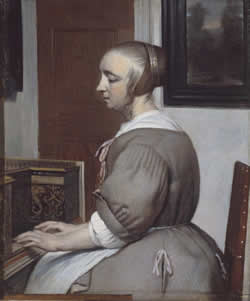
Gabriel Metsu
1662
Oil on panel, 23,9 x x 19.9 cm.
Petit Palais, Musée des Beaux-Arts de la Ville de Paris, Paris

Johannes Vermeer
c. 1670–1673
Oil on canvas, 53 x 46.3 cm.
Iveagh Bequest, London
Similarly, in The Guitar Player, (fig. 3) the young woman looms large in the picture plane. As if to lessen the effect of her full-on confrontation with the viewer, she is looking sideways rather than at us, although it is unclear what she is looking at. Her somewhat hesitant smile and knowing gaze suggest she may be exchanging glances with another person outside the picture plane. It implies a narrative of some sort but is ambiguous enough to save the scene from becoming too anecdotal. She is positioned unexpectedly far to the left and once again we see how she is cut off by the picture plane. As in The Leiden Collection picture, there is no longer anything between us and the protagonist. Perhaps more than in any other painting by Vermeer, there is a suggestion of motion in the Kenwood painting, as if we see a snapshot of a fleeting moment in time. As is the case with the women at a virginal, there is nothing unusual about the subject matter itself, but when we compare it to other artists' treatment of the same theme, we notice how here too Vermeer is in a league of his own.
It is clear that the yellow swall was added by another hand, painting over the original composition. Examination of X-rays has brought forth evidence of a carefully executed dress beneath this later addition. Precise technical analysis (Sheldon/Costaras 2006; Liedtke 2006) has established, among other things, that the canvas sued for this little painting comes from the same bolt of cloth as the canvas used for The Lacemaker onw in Paris. At the time of Vermeer's death, however, ten pieces of canvas (presumably already primed and ready for use) were to be found in the artist's studio Montias 1989, p. 341, doc. 364, no. 11); so this latest discovery is not a sufficient argument for Vermeer's authorship of the present work.
EV note: The picture in quetion is among two works whichn Schütz considers as "questionable attributìons."
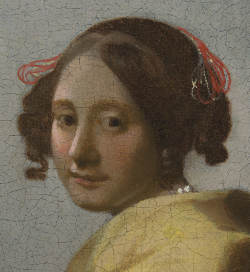
(attributed to Johannes Vermeer)
c. 1670
Oil on canvas, 25.2 x 20 cm.
Private collection, New York
Although the painting was included in earlier catalogues of Vermeer paintings, down to that of Ludwig Goldscheider in 1958, lingering doubts about its authorship remained. In 1978 it was not included by Albert Blankert in his Vermeer monograph. brought out by the same Phaidon Press that had published Goldscheider. When the painting came onto the market in the 1990s, Gregory Rubenstein of Sotheby's launched an exhaustive campaign on its technical and stylistic properties. When after ten years he presented the results to a group of specialists, the restorers and conservation scientists among them all agreed that it was painted by Vermeer, and that all the art historians dissented. Basically, I suspect, they simply could not believable that an artist that they had admired as greatly s Vermeer could have given one of his signature ladies such an insipid expression. (fig. 4) She does not even seem to look at us straight in in the eye, as do the others. Another weakness is the treatment of the pearl necklace, which is visible only in two shining pearls at the back of the neck.
Since the auction in 2004 the attribution to Vermeer has gained more general acceptance. Walter Liedtke put it in his catalogue of 2008, and displayed it in the Metropolitan Museum of Art, on loan, as a Vermeer. Dissenters remain.
The similarities between motifs in this picture and four late paintings by Vermeer (The Guitar Player, The Lacemaker, A Lady Seated at the Viutginal, A Lady Standing at the Virginal) might be taken as evidence of authenticity or imitation. Even in the double shadow behind the music stand, (fig. 5) the bluish white illumination of the wall, and its slight irregularities (fig. 6) could be interpreted as extremely subtle derivations from late works by Vermeer, assuming the imitator had access and the expertise to simulate their unusual effects. However, technical analysis and conservation have revealed that the painting is at least 250 years old and that it was made from the ground up with materials and methods distinctive of Vermeer (as explained at length in Sheldon Costaras 2006*).
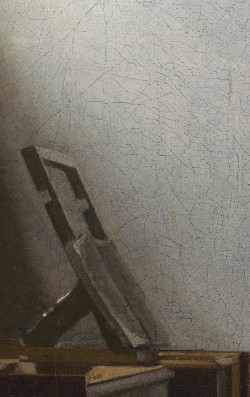
(attributed to Johannes Vermeer)
c. 1670
Oil on canvas, 25.2 x 20 cm.
Private collection, New York

(attributed to Johannes Vermeer)
c. 1670
Oil on canvas, 25.2 x 20 cm.
Private collection, New York
The present writer considers the technical evidence in favor of Vermeer's authenticity convincing. Moreover, the conception and execution of the picture, except for the yellow shawl, is consistent with several works by the artist. The Lacemaker, of almost exactly the same size, also sets the figure and furnishings against a bare background. To be sure, there are fewer refinements of design in the Rolin picture ( A Young Woman Seated at the Virginal), but this tendency is also found in The Guitar Player, which some viewers might regard as a less coherent composition. Perhaps the least satisfactory aspect of the painting is something that its original owner probably never had a chance to see, and that is its derivation from the London pendants. It is conceivable that Vermeer was asked for a picture of the same theme, at a time when any sale was welcome. And it is possible that three different pictures of a young woman playing a virginal (or clavicin) by Vermeer are cited in early documents. In any event, three versions of the subject, by Vermeer, are known today.
* Libby Sheldon and Nicola Costaras, "Johannes Vermeer's 'Young woman seated at a virginal,'" in The Burlington Magazine, vol. CXLVIII. February 2006. 89–97.
The painting demonstrates the extreme simplification if form with which Vermeer experimented in his late works. As in many of his works from this period, the principal plane of focus is not the objects closest to us (which are deliberately blurred), but rather the luminous wall in the background. As or eyes search for optical detail, we are drawn deeper into the composition, closer to the young woman, personalizing the intimacy of the scene. The textural modeling of the paint in the background to the rough, irregular surface of a plaster wall is a virtual trademark of the artists, also seen in paintings like The Milkmaid.
Brian Sewell
"Vermeer cannot be genuine" London Evening StandardJuly 9, 2004
<http://www.standard.co.uk/showbiz/vermeer-cannot-be-genuine-7229240.html>
If, among Dutch painters of the seventeenth century, Rembrandt has a rival for the affections of the general public, he is Johannes Vermeer, the contrast quite extreme. On the other hand we have a man whose paintings we see as utterly still, the ordinary existence of the ordinary figures in them elevated into art by freezing all in the silent harmony of mathematics, their ordinary activities made mysterious by the passionate intensity with which they are observed.
Nothing of Rembrandt's sound and fury echoes in Vermeer's silent rooms, nor in his street, nor in his city, and the whole of Delft is seized in mute tranquility. We are excluded: Rembrandt invites us to his feast, but Vermeer turns us into peepers at the door.
Rembrandt was both heir to the then ancestral traditions of European painting as observer, theologian, classicist, philosopher and storyteller, and the innovator who, like Titian, made new ways of painting possible, his influence profound, immediate and lasting over centuries.
With Vermeer, however, we are lost for words, can find few roots and, emphatically, no followers; fumbling, we match his mood to Leonardo's enigmatic Mona Lisa, or look still further back to the hushed composure of Piero della Francesca's sacred conversations, sensing the same enigma in artists far apart in time and place.
To look forward for his influence is a pointless exercise, for, unlike Rembrandt, Vermeer had no pupils or acolytes to help unlock the still mysteries that still us too.
We know very little of the man: born in Delft in 1632, at 21 a master joining the Painter's Guild of St Luke, father of 15 children and dead at 43, deep in debt rather than poverty
A document of 1672 described him as an expert on Italian paintings and, from a posthumous petition, we know that he bought and sold them. We know that, as a painter, he had the respect of his peers, for, in four years, they appointed him head of their guild, the first time when he was only 30.
From a working life of 22 years, only some 35 paintings survive that are signed or reasonably attributed to him, and on the two that are unarguably dated—1656 and 1668—art historians have constructed a dozen contentious chronologies.
With so few authentic paintings to his name, the addition of one more is far more important than, say, the discovery of yet another Rembrandt. One, which has been touted for sale by Sotheby's for the past three months, sold two days ago for £16.2 million.
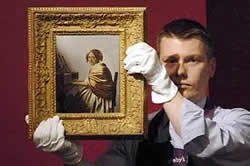
Many of us saw Young Woman Seated at the Virginals hanging in the National Gallery three summers past with a dozen indisputable Vermeers (and one disputed) in the exhibition Vermeer and the Delft School.
It was there as an addendum, not catalogued, inviting comparison and comment; mine was that only a glance was required to identify it as an "irredeemable dud" and an outspoken Dutch art historian, thinking it a forgery, described it as a "tasteless mishmash" of the two paintings by Vermeer in the gallery's permanent collection.
Since 2001, however, six Dutch "experts," one English and one from Sotheby's, have formed a research committee and given it their support; for the moment it is, perhaps, more Vermeer than not.
It has been "lightly cleaned". Records of this procedure suggest that what we could see in 2001 was a skin of dirt and distorting restoration virtually concealing what is, or may be, a worn and damaged painting of the seventeenth century.
With this skin removed, the condition of the image was so ruinous that it required a "light" restoration sufficient to all but conceal the original once more.
The claim now made by the research committee that this enables them to state, unanimously, that "the artist in question is Vermeer" and date the picture to circa 1670 is patently absurd, for what is visible on the surface of the canvas and what makes sense of the damaged image beneath, is entirely the intervention of a restorer in the infant years of this young century. An old restoration has been replaced by a new, and, if Vermeer ever had anything to do with the canvas, his contribution is sandwiched between it and the surface.
Nothing is known of the picture before 1904—its earlier ownerships and whereabouts are matters of possibly, probably, if and but. Scientific analysis revealed that the painter made extravagant use of ultramarine (lapis lazuli), the most expensive pigment available to 17th century Dutch painters—but, as the painting is very small, this can hardly be a matter of phenomenal significance.
Analysis also identified extensive use of lead-tin yellow, a pigment that the committee asserts was obsolete by the end of the seventeenth century; it was not—the recipe for making it was included in CP Pranger's Farben Lexikon published in Germany in 1782.
The canvas, all 70 square inches of it, is, says the committee, "almost certain" to have been cut from the same bolt as the 80 square inches of The Lacemaker in the Louvre and must therefore have been painted at much the same time, c. 1670.
But they do not ask themselves the dimensions of a bolt—many yards long and perhaps more than two in width, and canvas from it thus sold in shorter lengths to perhaps a dozen painters of the day.
If Vermeer's lifetime's work on canvas were measured against a single bolt, I suspect that 90 per cent of it would not have to be unrolled; averaging one picture every eight months or so, Vermeer is unlikely ever to have bought a bolt.
Then the costume expert on the committee had her say. The hairstyle was in fashion, it seems, only from 1669 until 1671. Good heavens, even the hideous wet-ringlet look of the 1990s stayed in fashion with the women of south Essex longer than that; were the women of 17th-century Delft faster off the mark than they? If they were, then surely four other paintings must be redated and much else of Vermeer's chronology recast.
As for the costume, is any other of Vermeer's players of musical instruments as hampered by a heavy wrap-round shawl? He was so extraordinarily scrupulous and delicate in his descriptions of shoulders, sleeves, forearms, jackets, ermine, lawn and lace, always communicating the physical forms within them, that the yellow blanket muffle about this girl's shoulders seems totally improbable, both as a garment and as an element of interest to Vermeer.
It is as crude a nonsense as the pig's trotters with which she plays her instrument. It is on these and other half-truths and suppositions that the authenticity of this nasty little picture depends.
Far from representing "an extremely important addition to our understanding of Vermeer's artistic development," this picture, if we accept it as genuine, distorts it.
I must argue that in no genuine Vermeer are the fold-forms of the costume so unrelated to the figure within, that shadow is never so impenetrably deep and destructive of the field of color, nor so heavy and unrelieved by reflected light as down the sitter's back, silhouetted against the wall behind.
Above all, I must argue that the most profound difference between this picture and genuine Vermeers lies in its composition: too facile and intellectually undemanding, the figure posed too easily parallel to the picture plane, pictorial space too cursorily defined, the whole deprived of the tensions that Vermeer so skillfully introduces in other compositions.
Unlike these, nothing is cut by or abuts the frame, no elbow is lost, no chair back chopped and there is no foreground clutter to act as a repoussoir and define the space.
A moment's comparison with the Guitar Player in Kenwood, usually dated to the late 1660s and in remarkably good condition, demonstrates the complexity of Vermeer's pictorial construction even in small paintings, and the fraudulent simplicity of the Sotheby picture.
It entirely lacks the exceptional spirit of Vermeer's art, his ability to take a plainfaced serving wench, rotate her away from the spectator and then call her to respond with a turn of the head and casting of the eyes, and, from this very ordinary stock of features, make a masterpiece.
This is the simplicity that sets Vermeer apart, yet it is not constant; the sequence of domestic interiors includes some of great complexity and detail, and it is broken by two pictures of operatic grandeur in which he proclaims his Catholic faith and his credo as a painter, staging his figures in set pieces rich with allegory.
Such works, creaking under the weight of a significance that we now cannot fully understand, suggest that Vermeer was, as Gainsborough might have put it, more "various" than we suppose.
Certainly his studio props seem to have been few in type and number, but they were as often palacerich as kitchen-poor and far from mundane, the subtle marvels that he performed with them addressed to a more educated, more intuitive public than that satisfied with pictures of jolly peasants in a tavern with dogs defecating at the door.
Vermeer not only transcended the commonplace business of daily life, but ignored and evaded it. Nothing of this superiority is to be found in the Sotheby picture.
Sotheby's, to those who know how to recognize a caveat in an auctioneer's catalogue, has not been deceitful: "Almost certain…to some extent reworked by another hand…part of the picture was brought to completion after the rest of the composition, perhaps as much as a few years later" are phrases that suggest hesitation.
But, advised by "experts" unanimous in their assertion that the picture is "unquestionably seventeenth century" and by Vermeer, Sotheby's could hardly refuse to catalogue it as genuine and sing its praises—and yet its estimated price when the sale was announced last April was a mere £3 million, far too little for the real thing and far too much for an uncomely dud.
In the event it seems that two men, rich and credulous, were gulled by the committee of experts, one of them the winning bidder, the other the unsuccessful underbidder dropping out of competition at the bid below.
For the moment, the enormous sum of £16.2 million for a painting so damaged and abraded that only modern restoration makes it fit to see, will be interpreted by ingenuous journalists as corroboration of the proofs offered by the experts.
But the history of Vermeer in the 20th century is littered with false attributions and downright forgeries enthusiastically attested by the experts of the day, and I confidently predict that the Sotheby picture will join them as an object of derision—£16.2 million is monumental proof of folly, not authenticity.
...The Girl at the Virginals is a reduced version of Vermeer's late painting A Lady Seated at the Virginals. The compositional weaknesses in this little work, particularly the awkward pattern of folds in the cloak, have suggested to some that the painting was executed by Vermeer at the very end of his career, at a time when is artistic powers had substantially declined. The arguments are not convincing, for even in Vermeer's late works one can never find such simplified treatment of folds and textures.
A picture often excluded is illustrated, A Lady Seated at the Virginals in the Beit Collection. The lady's shawl may have been retouched, but the picture is substantially by Vermeer. One passage alone, conveying the space and light between the figure and the reflecting surface of the virginals, is enough to place it outside the range of any other painter. It is a melancholy relic, perhaps the only picture that we have painted after 1672, when Vermeer let the house in the Groote Markt, whose painting-rooms we know so well, and moved to the smaller one in the Oude Langendijk where he died in 1675.

Walter A. Liedtke and Arthur K. Wheelock Jr., 2017
; revised by Arthur K. Wheelock Jr., 2023 Leiden Collection website <https://www.theleidencollection.com/artwork/young-woman-seated-at-a-virginal/
(2023)
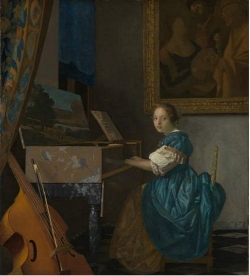
Johannes Vermeer
c. 1670–1675
Oil on canvas, 51.5 x 45.5 cm.
National Gallery, London

Johannes Vermeer
c. 1670–1673
Oil on canvas, 53 x 46.3 cm.
Iveagh Bequest, London
This entrancing picture, the only one of Vermeer’s mature works remaining in private hands, captures the quiet joy of a young woman in harmony with her music. As she gently and tenderly fingers the keyboard of her virginal, she leans slightly forward in her chair while looking out with a sympathetic expression, as though desiring to share the dulcet sounds of her instrument with the viewer. In style and execution this small masterpiece is similar to other of Johannes Vermeer’s late depictions of young women playing musical instruments, including The Guitar Player, c. 1670 (fig. 8), Kenwood House, London; A Woman Standing at a Virginal, c. 1670–1672 (fig. 9), The National Gallery, London; and A Young Woman Seated at a Virginal, c. 1673–1675 (fig. 7), also in The National Gallery. Aside from its comparable subject matter, this elegantly subtle painting shares with these other late works Vermeer’s sensitivity to light and his subtle rendering of flesh tones. Similarities also exist in his manner of modeling of the satin skirt, the reflective front of the virginal, the distinctive geometry of the music stand, and the radiant white wall that serves a luminous backdrop for the figure.

Johannes Vermeer
c. 1670–1674
Oil on canvas, 51.7 x 45.2 cm.
National Gallery, London
The variance in approach between the underlying and final versions of the yellow shawl, however, is quite substantial and suggest that some time passed before Vermeer revised the garment. The broad, sweeping folds, with their sharp, unmodulated edges, are quite different from Vermeer’s more nuanced manner of painting in the early 1670s, as seen, for example, in the yellow jacket in Vermeer’s The Guitar Player. It was largely because of the distinctive executions of this shawl that the attribution to the artist, or at least of the yellow shawl, has been contested in the past. The closest comparison to the expressive character of this yellow shawl is the modelling of the blue dress in A Young Woman Seated at the Virginal in the National Gallery, London (fig 7), which, for stylistic reasons, likely dates around 1673–75. In both works one finds broad sweeping folds with little modulation between the highlights on their ridges and the shadowed pockets between them. It is thus likely that Vermeer returned to the Leiden Collection’s Young Woman Seated at a Virginal at about this time to replace the underlying yellow garment with the yellow shawl.
Vermeer probably made this revision to update the woman’s clothing so that it would be compatible with the more flowing style of dress fashionable in the mid-1670s. Ermine-bordered yellow jackets, such as the one seen in The Guitar Player, went out of favor after 1672, the devastating Rampjaar (Disaster Year) when French and Germans forces invaded The Netherlands. The flowing shawl gave the young woman a more timeless, classical look than evident in her previous mode of dress. Although the hostilities during the Rampjaar negatively affected the art market, it seems unlikely that Vermeer stopped painting in 1672, as some have postulated. Indeed, after Vermeer’s death in December 1675, the artist’s widow, Catharina Bolnes (c. 1631–1687), lamented that he had "been able to earn very little or hardly anything at all" because of the war with the King of France. At his death Vermeer left "ten painter’s canvases" among the supplies in his studio, another indication that he was still active as a painter. Much as Gowing postulated, Vermeer likely made his revisions to Young Woman Seated at a Virginal during the last year of his life. Whether he did so on his own initiative or because of a patron’s request is a fascinating question that, tantalizingly, remains open.
Sotheby's Sales Catalogue NotesThe following article has been extracted from the Sotheby's sales catalogue: A Young Woman Seated at the Virginals | OLD MASTER PAINTINGS, PART 1 L04031 | London, New Bond Street, July 04, 2004 (Publication Code: L04031)
This picture (fig. 10) was painted by Johannes Vermeer in about 1670. It is the last original composition by Vermeer left in private hands, the first to be offered at auction since 1921, and the first to be sold by any means since 1955. Inaccessible to scholars except through old photographs, the picture was for many years either dismissed or ignored completely, but, following recent extensive examination and analysis and also some light cleaning and restoration, its authenticity is now no longer disputed by any of the leading scholars of Vermeer, nor by any of a wide circle of scholars of seventeenth-century Dutch painting who have had the opportunity to study it at first hand.
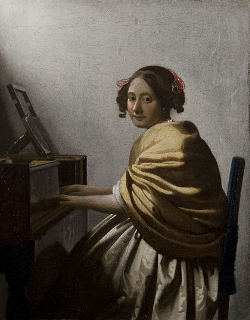
(attributed to Johannes Vermeer)
c. 1670
Oil on canvas, 25.2 x 20 cm.
Private collection, New York
Ever since his rediscovery in the 1860s by the French art historian Thoré-Bürger, Vermeer has had a unique and somewhat mysterious position in the history of seventeenth-century Dutch art. Unquestionably a genius, with a gift for the creation of contemplative mood and serene atmosphere that few if any have equaled, his works and style nonetheless had relatively little influence on his contemporaries. Although some of his paintings always retained their correct attributions, others did not, as his name became more or less entirely forgotten not long after his death.
Part of the reason for the lack of any lasting influence must have been that Vermeer, as has been so well described in recent scholarly and popular literature, worked in a very personal way, and seems to have had no pupils to whom these methods could have been passed on. While another artist could, perhaps, have imitated Vermeer's general approach to composition without actually training with him, the specific effects of color and lighting that ultimately define his style and his genius were largely the result of the precise mixtures and combinations of pigments and grounds that the artist applied to his canvases, allied with a particular gift for infinitely subtle modulations in tone. Maybe these techniques could never have been passed on to others, but in any case such a thing could only ever have been possible through a traditional, direct apprenticeship in Vermeer's studio. It has, however, been agreed since the earliest days of Vermeer scholarship that he had no such apprentices or pupils: not only is there no documentary record of any such arrangement (apprenticeships had to be registered with the local painters' guild), but there is also no body of surviving work, painted using Vermeer's techniques and pigment combinations, but not actually by him, which would be the necessary result of his having had pupils.
A second factor contributing to Vermeer's eclipse in the eighteenth- and earlier 19th-century literature of art must surely have been the sheer rarity of his works. Most modern scholars agree that there exist a mere 36 surviving works by Vermeer, and that while he must have painted a few other pictures that are now lost, the paintings that are known today nonetheless constitute the great majority of his entire output as an artist. Already by the eighteenth century, these 36 paintings were dispersed through Germany, France, Italy and England as well as Holland, so there were simply too few works by the artist available to earlier scholars of Dutch art for them to form a view of his style.
Once Thoré-Bürger had identified and defined Vermeer's style in his ground-breaking publications in the Gazette des Beaux-Arts of 1866, the corpus of the artist's paintings did, however, very rapidly coalesce, and although the early works continued to be debated even after the Second World War, by the early 20th century all the characteristic, original works of Vermeer's maturity that are known today had already entered the literature. No previously unknown work of this type by Vermeer has been discovered in the past century, and it is therefore all the more significant that following a programme of research lasting more than 10 years, a panel of leading international scholars and conservators has now concluded that the present painting of A Young Woman Seated at the Virginals is indeed an autograph work by Vermeer, dating from around 1670. Although this painting has been long recorded in the literature, the confirmation of its previously disputed attribution represents an immensely important addition to the oeuvre of the mysterious Delft master.
The painting represents a musical theme familiar from several of Vermeer's larger paintings, in particular the two in the National Gallery, London. It shows a young woman, three-quarters length, seated on a chair of rich blue velvet, her hands extended towards the keyboard of the virginal, a variant of the same instrument shown in one of the National Gallery's paintings. She is dressed in a yellow woolen shawl above a white satin dress or skirt, with pearls around her neck and an arrangement of red and white ribbons in her hair. As in Vermeer's other small canvases, the figure and instrument are set against a plain wall, without any other compositional elements such as windows, curtains or background paintings; yet despite this, the artist has created a highly convincing and atmospheric impression of space and depth, thanks to the depiction of minute irregularities and holes in the plaster of the wall, and the presence of a delicate, unified light, which comes, as in most of Vermeer's interiors, from the top left of the composition.
Very few paintings by Vermeer have been seen on the market since the 19th century, when the great majority of the artist's known works were acquired either by the museums where they now reside, or by the collectors who subsequently gave them to those museums. During the last century, only one has ever been offered at auction The Little Street, now in the Rijksmuseum, Amsterdam, in 1921), and even including sales through dealers hardly a dozen works by Vermeer have been sold in that time. No other characteristic painting by the artist has changed hands since the 1950s, and A Young Woman Seated at the Virginals is the only such work that still remains in private hands.
Provenance
It is possible, though far from certain, that this was one of the group of 21 pictures by Vermeer owned by the Delft bookseller and printer Jacob Dissius, who had inherited them from his father-in-law, Pieter van Ruijven, the man who seems to have been Vermeer's most important patron. Dissius's paintings were sold in Amsterdam on 16 May, 1696. Unfortunately, the catalogue of this sale does not give the dimensions of the pictures, only a brief description of the subject of each, but in many cases this is still enough to identify the pictures that are known today, and some useful information can, therefore, be deduced from the prices realized by each painting. These ranged from the 200 guilders paid for the famous View of Delft (The Hague, Mauritshuis) down to 17 guilders paid for each of two unidentifiable tronies (a term used in the seventeenth century for a small painting of a single figure, shown head-and-shoulders, in an exotic or historical costume). After the View of Delft, the next two most expensive pictures were The Milkmaid (Amsterdam, Rijksmuseum) which made 175 guilders, and the Woman Weighing Gold (National Gallery of Art, Washington, 155 guilders). In the middle range of prices were pictures such as The Music Lesson (London, The Royal Collection, 80 guilders), the Concert (currently missing from the Isabella Stewart Gardner Museum, Boston), which made 73 guilders, and the Woman writing a letter (Washington, National Gallery of Art, 63 guilders). One picture, lot 37 in the catalogue, is described as Een Speelende Juffrouw op de Clavecimbael (A Woman playing the Virginal). In terms of subject, this could either have been the picture now under discussion or one of the two now in the National Gallery, London, and the price it fetched, 42 guilders and 10 stuivers, does not help in clarifying which it actually was, since this seems a very low price for a major work such as one of the London pictures, but also perhaps rather high for a picture as small as this one. Another early sale reference can be linked with rather more certainty to the present picture. Lot 93 in the Amsterdam sale of the collection of Wessel Ryers, on 21 September, 1814, was described as a painting on panel by Vermeer of a young woman playing a clavichord, 10 inches by 8 inches. Other errors in the description of supports in this catalogue suggest that the fact the picture is described as being on panel rather than canvas should not be taken too seriously, and the dimensions given suggest very strongly that the picture sold must have been the present work, rather than one of the National Gallery pictures or a further, lost representation of the same subject.
The whereabouts of the present picture has, however, been securely documented since 1904, when it was published in the preliminary catalogue by Dr. Wilhelm Bode of the collection of Alfred Beit (fig. 11) a South African-born diamond magnate who was one of the few European-based collectors to rival the great early 20th-century art acquisitions of Americans such as Frick and Mellon. Beit, the majority of whose collections were eventually given to the National Gallery of Ireland in Dublin, owned many great Dutch pictures of the seventeenth century, including another Vermeer, the Lady Writing a Letter, though when and where he acquired either of his Vermeers is not now known. When Beit died, the picture passed to his brother, Otto Beit, and then the latter's son, Sir Alfred Beit (fig. 11), who eventually, in 1960, placed the picture on consignment with a London dealer. There it was seen by Baron Frédéric Rolin of Brussels, at the time a dealer in tribal art, who was also an occasional collector of Old Masters. Rolin fell in love with the picture, and even though he was aware that the attribution to Vermeer had by then been questioned, he acquired the little painting, in the time-honored fashion of collectors who fall in love with a work of art, by giving in exchange four others from his collection, paintings by Klee, Signac, Bonnard and Riopelle. Baron Rolin died in 2002, and the painting is now offered for sale by his heirs.
Earlier Critical History
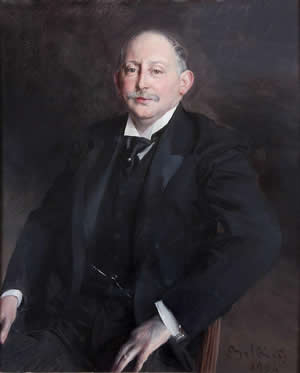
Giuseppe Boldini
1906
During the initial decades following its first publication in 1904, the picture was universally accepted and published as an autograph work by Vermeer. In the period before and during the Second World War, it was unanimously recognized by scholars, including Wilhelm Bode, Cornelis Hofstede de Groot, A.B. de Vries, Eduard Plietzsch and Ludwig Goldscheider. Then, following the dramatic events of the affair of the Van Meegeren forgeries of Vermeer, De Vries, the Director of the Rijksmuseum, Amsterdam, and the recognized leading scholar on Vermeer, expressed doubts about the authenticity of the picture, doubts which he published in 1948, in the second edition of his book. Despite the fact that not long after this De Vries changed his mind again, in favor of the painting, and wrote several letters saying that if his book were to go into a third edition he would unequivocally rehabilitate the picture, the seeds of doubt were sown. In the event, no third edition of De Vries' book was published, and the relative inaccessibility of the picture, particularly after its sale from the Beit collection in 1960, meant that subsequent scholars of Vermeer were inclined to relegate it to the margins of the artist's work. A few, including Lawrence Gowing (1970) and Christopher Wright (1976) continued to accept it, but others, for the most part basing their assessments on poor old photographs, dismissed it, in an increasingly perfunctory way. Only during the last decade, since the picture was brought back into contact with the scholarly community, has it been examined seriously, and in the light of modern research and technology.
The first steps in the research programme
In 1993, Sotheby's was approached by Baron Rolin, with a request to undertake new research on the painting. It was agreed that a useful first step would be to compare the painting with the two larger representations of similar subjects in the National Gallery, London. The National Gallery generously agreed to remove their pictures from display and take them to the conservation laboratory, to enable the pictures to be compared under microscopes. Opinions on that day were divided: the conservators present (including David Bomford and Ashok Roy) unanimously felt that the three pictures they were looking at under the microscopes were all by the same hand, but the art-historians were less positive, saying that the stylistic and compositional differences between the pictures left the attribution of the small Rolin painting far from confirmed.
After this mixed reception, it was eventually decided that no further clarification would be achieved without a detailed scientific analysis of the painting, to establish once and for all its physical composition: was it or was it not a genuine seventeenth-century painting, and if so, precisely what materials and techniques had been used in its making? To this end, a complete scientific study was begun in 1995 by Libby Sheldon of University College London, in collaboration with her colleague Catherine Hassall, and in 1997 Nicola Costaras of the Victoria and Albert Museum joined this team, bringing with her a considerable technical knowledge of Vermeer's work. This investigation demonstrated not only that the picture was unquestionably seventeenth-century, but also that its technical composition was entirely consistent with Vermeer's known working methods. In particular, the composition of the ground layers was found to be entirely comparable with other works by the artist, and the pigments used were also appropriate.
The pigments
In terms of determining the authenticity of the picture, the most significant pigments found during the scientific analysis were lead-tin yellow, green earth (fig. 12) and ultramarine.
Lead-tin yellow, which is here used throughout the yellow shawl, was very widely employed from the Middle Ages until the end of the seventeenth century, but became obsolete thereafter, and was replaced by other yellows such as yellow ochre and Naples yellow. Indeed, knowledge of this pigment was rapidly forgotten, and it was not until 1941 that a scientist discovered that there was a tin component in this typical seventeenth-century yellow which distinguished it from other, later lead-based yellows. The fact that lead-tin yellow was the pigment used for the yellows in this picture immediately proves that it is at the very least a seventeenth-century painting and not, as some have suggested, a later imitation of Vermeer's style.
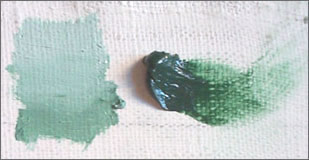
The pigment green earth was also found in the picture, used in the flesh tones. This pigment seems to have been used only very rarely by seventeenth-century Dutch artists, but is regularly found in the flesh tones in Vermeer's works. Otherwise, the use of green earth seems to have been limited to the Utrecht school. It is interesting to note in this context that Vermeer's mother-in-law, Maria Thins, was in fact distantly related to Abraham Bloemaert, and herself possessed a significant collection of paintings by various Utrecht artists.
Libby Sheldon's most important discovery as regards the pigments used in this painting relates, however, to by far the most expensive pigment available to a seventeenth-century Dutch artist, namely ultramarine. Made from ground lapis lazuli, this pigment was used to create blues of remarkable richness and depth, but on account of its great cost was only rarely used by artists of the period, and then only very sparingly, and in a very conspicuous way. Vermeer, however, used this pigment very extensively, not only for the small areas of rich deep blue that are so characteristic of his paintings, but also incorporating it, invisibly, in the creamy tones of his background walls. The subliminal enriching effect of this invisible use of the pigment is hard to quantify, but clearly Vermeer believed it was necessary to achieve the effects he desired; and this specific extravagance is something that has never yet been found outside the work of Vermeer. In the present picture, ultramarine is used in precisely this way, not only in the blue velvet chair back, but also, invisibly to the naked eye, throughout the background wall.
The canvas and priming
An immediately striking feature of the canvas used in this painting is that, although it is small in size, the weave of the fabric is relatively coarse; usually, when seventeenth-century artists made small canvas paintings, they used canvases made of much finer fabric, with a much higher thread-count per centimeter. The relatively rough canvas seen here is, however, exactly the same as that used by Vermeer in his only other canvas painting on this scale, The Lacemaker, in the Louvre. The similarities between the canvases of these two paintings do not stop there. Normally, canvases of this period show a significant difference in the thread count in each direction, creating a clear distinction between the "warp" and the "weft," but in both these paintings the thread count in each direction is almost identical (12 threads per centimeter in each direction), which is extremely unusual in seventeenth-century Dutch painting. Furthermore, the minor irregularities in the weave of the fabric, which are always present in canvases and can be clearly seen on X-rays, show such similarities in pattern that it is almost certain that both canvases were cut from the very same bolt of cloth. What is more, the priming layers in each painting are also remarkably similar. Although many Dutch grounds, and particularly Delft grounds, appear similar in color and texture to the naked eye, they do in fact vary significantly when cross-sections are analyzed under the microscope, in terms both of the combinations of pigments that are present, and also of the microscopic sizes of the particles of each pigment, which are the result of the process of grinding the pigments in the artist's or canvas-merchant's workshop. The ground in this picture contains precisely the same combination of pigments as do those of several of Vermeer's other paintings (notably the two National Gallery London paintings, and The Lacemaker), and the particle sizes are absolutely the same as in The Lacemaker, which means that both canvases must have been grounded at exactly the same time.
Other technical features
Sheldon's study also revealed other significant facts, most importantly the presence in the picture of the characteristic pin-hole that is found in many of Vermeer's pictures, at the vanishing-point of his perspectival scheme. She also found evidence, visible in the X-rays, of compositional changes that had been made to the picture, most notably in the yellow shawl. Originally it seems that the artist planned that the skirt would extend rather higher than it now does, and that the shawl would be consequently shorter; there is evidence that the initial blocking in of the folds of the skirt extend under the lower part of the present yellow shawl. In this lower area of the shawl, Sheldon also found two different layers of the same lead-tin yellow pigment, distinct, but with so little separation between them that they must have been applied within at the most a very few years of each other. The twin questions of whether the reworkings and revisions in the yellow shawl were made by the artist of the rest of the picture, and whether these changes were made as artistic revisions or to correct technical or condition problems could not be answered by this type of technical analysis, but Sheldon's description of the physical construction of this part of the painting is highly important, because this lower section of the yellow shawl is the area that has been the focus of much of the negative criticism of the picture's overall appearance. Although it should be noted that the yellow areas in Vermeer's other paintings are often those in which there are the greatest problems as regards condition, there is no question that this is the most problematic part of the present painting. The structure of folds and shadows in the lower areas of the yellow shawl is not handled in a manner typical of Vermeer, and although careful study of the draperies in the artist's other paintings does reveal a fairly wide range of different techniques, it seems possible that this part of the painting was to some extent reworked by another hand, either because the original glazes that defined the shadows in the drapery were damaged, or because this area remained to some extent unfinished. Lastly, Sheldon's study also revealed that although the great majority of the picture surface was in fact very well preserved, there were nonetheless many tiny later retouchings, perhaps 19th-century in origin, which clearly had a significant effect on the painting's overall visual appearance.
The second phase of the research programme
Following the initial confirmation that on a technical level the painting was completely consistent with Vermeer's work, other side-by-side comparisons were made in New York in late 2000, after which Walter Liedtke requested the loan of the painting as a last-minute, ex-catalogue addition to his exhibition, Vermeer and the Delft School, which was due to open in New York a couple of months later, in March 2001. There, and subsequently also at the National Gallery, London, the picture was hung together with the National Gallery paintings and others, and the question of its attribution and authenticity was once again much discussed. The general conclusion from this debate was that the condition of the yellow shawl and the presence of the various later retouchings were together affecting the overall visual impression given by the picture to the extent that no firm conclusions about its attribution could be reached. It was therefore decided that a careful cleaning and restoration, coupled with further research and investigation, should be undertaken, and to this end an ad hoc committee was formed to oversee the whole project. The committee members were:
- Martin Bijl (former head of Paintings Conservation, Rijksmuseum, Amsterdam)
- Frits Duparc (Director, Mauritshuis, The Hague)
- Gregory Rubinstein (former Senior Director and Head of the Old Master Drawings Department Worldwide of Sothebey's)
- Libby Sheldon (University College London Paintings Analysis)
- Jørgen Wadum (former head of Paintings Conservation, Mauritshuis, The Hague)
- Arie Wallert (former head of Paintings Conservation, Rijksmuseum, Amsterdam)
- Ernst van der Wetering (former head of Rembrandt Research Project)
- Marieke de Winkel (Costume Expert, Rembrandt Research Project)
Under the guidance of this committee, the painting was lightly cleaned and restored by Martin Bijl in 2002–2003; the results of this restoration and the findings of the further research conducted by the committee members as part of the project are to be published in a collective group of articles in Oud Holland in the near future. Without pre-empting totally the contents of this forthcoming publication, the following are some of the main conclusions reached by the committee:
Many of the reservations that have been voiced about the picture over the years have resulted from the negative visual effects of later restorations, which though seemingly minor, had far-reaching visual effects. Following the removal of these restorations, it has been possible to see much more clearly the artist's original construction of space and lighting, and this has led the committee members to conclude unanimously that the artist in question was Vermeer.
After detailed comparison with draperies in all Vermeer's other pictures, it was agreed that the handling of folds and shadows in the lower part of the yellow shawl is untypical of the artist. Given that there are also two distinct layers of lead-tin yellow in this area, it must be concluded that this part of the picture was brought to completion after the rest of the composition, perhaps as much as a few years later. The committee members were, however, not able to conclude unanimously whether this later finishing within the yellow shawl was the result of damage in that area or because it had simply remained unfinished, or whether the final surface of this part of the yellow shawl was in fact painted by Vermeer himself at the end of his life, or by another hand.
The Rolin painting can be linked much more closely than was previously understood to The Lacemaker in the Louvre, a painting that is precisely the same size as this, and is the artist's only other canvas painting on this small a scale. Much more than this, the research of the committee has revealed that the canvas on which these two pictures were painted, which has a highly distinctive pattern of threads, almost certainly originated from the very same bolt of cloth, and that the two canvases were grounded using precisely the same combination of pigments.
In terms of dating the picture, Marieke de Winkel has concluded that on the grounds of costume and hairstyle, the picture must date from within a year either side of 1670, from the same time as the Louvre Lacemaker, and from slightly before the paintings in the National Gallery, London.
Martin Bijl's restoration of the picture in fact involved relatively little physical intervention. His chief tasks were the removal of the later retouchings, and a small amount of almost microscopic retouching of losses. Yet the transformation that this very minor intervention has brought to the overall appearance of the picture has been striking, and all those who have seen it both before and after restoration have agreed that it is only now that the picture conveys in a powerful and convincing way the sense of the figure's presence in a three-dimensional space, set in front of a tangible background wall from which she is convincingly separated. The cool, serene lighting so typical of Vermeer has also only now fully reappeared; for those who have now seen the painting again, the re-emergence of this characteristic work by the most atmospheric and distinctive master of seventeenth-century Holland is a most astonishing and moving event.








 Sotheby's Sales Catalogue Notes 2004
Sotheby's Sales Catalogue Notes 2004